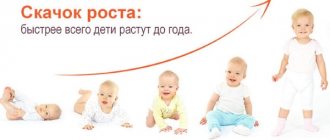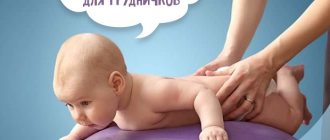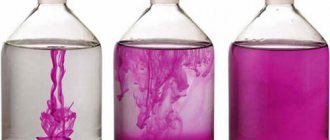List of antipyretics for children under one year of age
All modern antipyretics belong to a specific group based on the type of active substance. Good antipyretics include:
- paracetamol-based products (Efferalgan, Panadol, Paracetamol). They can be produced in the form of rectal tablets or suppositories, suspensions. Contraindicated for patients with liver disease, kidney disease, viral hepatitis, diabetes mellitus;
- medications that contain ibuprofen (Nurofen, Ibuprofen, Ibufen). Approved for use only from the third month of the baby’s life. They cannot be used for asthma, liver disease, kidney disease, hearing impairment, blood disease, ulcers, gastritis;
- homeopathic group of antipyretic drugs (Viburkol). Presented in the form of rectal suppositories. They have no age restrictions. They cannot be used if the components are intolerant.
Important! An antipyretic for a newborn (up to 1 month) from birth is prescribed exclusively by a pediatrician. Self-administration of the drug is dangerous due to overdose and side effects.
Next, we will look at which antipyretics are best to choose, taking into account their characteristics.
Antipyretic suppositories for newborns up to 1 year
The main advantage of antipyretic suppositories is the lower number of side effects compared to the liquid form. Suppositories are absorbed through the rectal mucosa without affecting the digestive tract. Flavorings and dyes are added to syrups. This dosage form may cause an allergic reaction in infants prone to allergies.
Antipyretic suppositories based on paracetamol
Candles Tsefekon D
Approved for use from 1 month of age.
- children weighing 4 – 6 kg (child’s age 1 – 3 months) – 1 suppository 50 mg;
- infants weighing 7 - 12 kg (child's age 3 -12 months) - 1 suppository 100 mg.
Apply no more than 3 times per day. The interval between doses is 4 – 6 hours.
Panadol suppositories
For a child under one year of age, it is necessary to purchase suppositories with a dosage of 125 mg of paracetamol in one suppository. Allowed for children from 6 months in a dosage of one suppository. It is allowed to place no more than 4 candles per day with 4-hour breaks. You can use it for 5-7 days. Panadol has an analgesic and antipyretic effect.
Antipyretic suppositories based on ibuprofen
Nurofen suppositories
Used from three months of age. One suppository contains 60 mg of ibuprofen. It is allowed to use the drug after 6 hours.
- children weighing 6 - 8 kg are prescribed 0.5 - 1 suppository no more than 3 times a day;
- if the baby's weight is 8.5 - 12 kg, 1 suppository is prescribed no more than 4 times a day.
Optimal antipyretic drugs for children
Even the most proven and safe drugs, according to experts, should not be given to children too often. Practice shows that side effects of some products appear several years after therapy. For example, a long course of paracetamol before the age of 1.5 years increases the risk of developing bronchial asthma in children. Only a doctor can determine how much, in what form and for how long to give a profile drug to a small patient.
But parents should also remember the following points:
- For fever in children, it is common to use drugs based on paracetamol or ibuprofen. The first is considered the safest in childhood and can reduce readings by 1.5 degrees for 2-4 hours. The higher the temperature, the shorter-term its effect will be. For very high data, ibuprofen can be used (if age allows). The effect occurs within a few minutes and is more pronounced and lasts longer.
- Products such as Antipyrine, Amidopyrine and their analogues are not used in pediatrics due to obvious toxicity.
- Aspirin can only be used when the child is 15 years old. Otherwise, the product may cause side effects that are incompatible with life.
- Analgin is not recommended for children, because has a wide range of side effects, including a decrease in temperature to too low numbers, anaphylactic shock, and allergic manifestations. Only intramuscular administration of the drug is permissible strictly under the supervision of a physician.
Particular attention should be paid to the choice of pharmacological form of the drug:
- Syrups and solutions begin to act within 20-30 minutes. But they contain sweeteners that can cause allergies.
- Candles give effect approximately half an hour after placement, but have a longer and more pronounced effect. They are indispensable when a child is vomiting or is unable to take medicine. They are best placed at night, when the baby has already gone to the toilet.
It is strictly forbidden to exceed the dosages specified in the instructions for the product or as stated by the doctor. If the product does not give the desired effect, it will have to be changed, but only with the permission of a specialist. Parents should remember what reaction which drugs cause in their child in order to simplify the process of prescribing therapy in the future.
Suspensions and syrups for children from one month to 1 year
There is often confusion with the name of liquid antipyretic drugs for children in terms of classifying them as syrups or suspensions. The basis of syrups is a concentrated aqueous solution of sucrose and/or its substitutes, and suspensions are a liquid medium in which particles of the active substance are distributed in suspension. Over time, with prolonged standing, these particles can settle to the bottom, so the suspension must be shaken before using. Both taste sweet, but in syrups the sweetness is mostly due to sugar (most often sucrose), and in suspensions, sweeteners (for example maltitol) and/or sweeteners, much less often sucrose. Sweeteners are able to be absorbed by the body because they provide energy value, while sweeteners are substances that are not a source of energy, although they taste sweet. Therefore, if a child is prone to allergies, it is better to choose a product that does not contain sucrose.
Antipyretic suspensions based on ibuprofen
Used from three months of age. It is allowed to use the drug after 6 hours.
Suspension Nurofen
Analogues are Ibuprofen suspension, Ibufen suspension, Bofen suspension.
How to give:
- infants 3–6 months old weighing at least 5 kg are prescribed 2.5 ml 1–3 times a day;
- if the child's age is from 6 months to 1 year, use 2.5 ml 1 - 4 times a day.
Antipyretic suspensions and syrups based on paracetamol
Children from 3 months to one year can take 60-120 mg of paracetamol at a time. If the child has not yet reached three months, then the dose is calculated based on the child’s weight - 10 mg per kilogram. It cannot be used more than 4 times a day. Children under 3 months. used only after medical prescription.
Panadol suspension
How to give:
- with a body weight of 6-8 kg, 4 ml of suspension is prescribed;
- 8-10 kg - 5 ml of Panadol suspension.
Efferalgan syrup
The dosage is carried out using a measuring spoon, on which divisions are marked corresponding to the child’s body weight, starting from 4 kg and up to 16 kg at intervals of one kilogram. All even numbers are marked, and odd numbers are divisions without a number. Medicines must be taken as much as the child weighs. If the child has not reached 4 kg, it is not recommended to use the drug.
Calpol suspension
An analogue is a suspension of Paracetamol for children.
At the age of three months to one year, give the child from 2.5 ml (child’s body weight 4-8 kg) to 5 ml (child’s body weight 8-16 kg) of the suspension. Contraindicated for children under one month.
Video: Komarovsky about antipyretics
How to reduce a child’s high temperature - recommendations for parents
Fever in itself is not an indication for lowering the temperature. You should not strive to reduce it to normal; it is enough to reduce it by 1-1.5°, which is accompanied by an improvement in well-being.
At high temperatures, sufficient fluid should be administered (in the form of a water-salt solution, juices, fruit drinks, water, etc.), its total volume with food should be at least 120-150 ml/kg.
In case of severe fever, the child should be undressed and wiped with water at room temperature; This is often enough to reduce body temperature. If chills or trembling occur, an antipyretic should be administered.
It is necessary to avoid regular (course - 4 times a day) prescription of antipyretics; it has no advantages over the introduction of a repeated dose upon reaching a temperature level considered as an indication for its reduction. With this tactic, the effect of antipyretics is no lower than with a course of treatment, but this does not distort the temperature curve and reduces the total dose of the antipyretic.
The most common reason for prescribing antipyretics is acute respiratory infections, the duration of fever in which in 85% of cases does not exceed 1-2 days. The need to continue taking antipyretics for 3 days or more may indicate the presence of a bacterial infection, which requires re-examination.
The simultaneous administration of antipyretics and an antibiotic should be avoided - this makes it difficult to assess the effectiveness of the latter.
With the development of “pale” fever associated with impaired microcirculation, antipyretics are required, along with other measures (rubbing the skin, administering vasodilators, and in severe cases, droperidol into a vein).
A significant part of the population has developed pyrophobia - a fear of elevated temperature, which forces parents and doctors to look for “powerful” antipyretic drugs. And this is despite the fact that fears regarding damage to the brain, heart, development of coma, and especially death due to fever have not been confirmed. Nevertheless, antipyretics (for example, for acute respiratory viral infections) are prescribed to 95% of sick children.
The use of antipyretics aims to create more comfortable conditions, therefore the use of paracetamol as a first-line drug is fully justified. In this regard, the ongoing search for “more effective” schemes for reducing temperature is surprising: using alternation of drugs. Such studies only support pyrophobic sentiments and mislead doctors regarding the tactics of using antipyretics.
Attention should be paid to the following points:
- temperature is a protective reaction; it should be reduced only when indicated;
- Adequate fluid administration to a febrile child is more important than reducing the child's temperature;
- in antipyretics, it is not “strength” that is important, but safety; to improve the patient’s condition, it is enough to reduce the temperature by 1-1.5 ° C;
- paracetamol is the safest drug, it is important to adhere to the recommended single and daily dosages;
- Antipyretics should not be prescribed in a “course” to prevent a rise in temperature, since the development of a bacterial infection can be observed;
- for the same reason, you should not use antipyretic drugs for more than 3 days without consulting a doctor;
- You should try not to give an antipyretic to a child receiving an antibiotic, as this makes it difficult to assess the effectiveness of the latter;
- if a “pale” fever develops with spasm of skin vessels, the administration of an antipyretic drug should be combined with vigorous rubbing of the child’s skin until it turns red and call a doctor immediately.
No matter how strong a child’s immunity is, no one is immune from a rise in temperature due to a cold or after vaccination. Despite the fact that the use of any medications should be carried out strictly as prescribed by the doctor, parents should know at what temperature it is necessary to urgently begin to reduce the indicators in order to prevent critical conditions.
First of all, you need to remember that you need to act strictly according to the situation. Despite the fact that many children's antipyretic drugs are considered universal, their dosages often depend not only on the age of the baby, but also on the type of pathological factor causing the fever. Give your child fever relievers only to support him until the doctor arrives. Such remedies do not treat the causes of the disease, they only provide temporary relief and prevent the development of more serious problems (for example, dehydration).
Antipyretic drugs prohibited for infants
- Combined tablets containing ibuprofen and paracetamol (Ibuklin Junior tablets). They can be used for children over 3 years of age.
- Analgin. It is not used for children. It can be used as part of a lytic mixture if it is not possible to reduce the temperature for a long time by other methods. Used only in extreme cases, as prescribed by a doctor and in his presence.
- Aspirin. It should absolutely not be used to lower the temperature of children under 12 years of age. The drug is dangerous due to complications and the development of dangerous pathologies.
Important! It is strictly not recommended to deviate from age restrictions when choosing an antipyretic drug. The components in the drug may act differently and cause side effects. For a developing organism, an inappropriately selected antipyretic can cause irreparable damage.
Children's syrups for fever: review of drugs, application
Paracetamol
Prescribed as: - an antipyretic for acute respiratory diseases, influenza, childhood infections, post-vaccination reactions and other conditions accompanied by an increase in temperature; - an analgesic for pain of mild to moderate intensity, incl. headache and toothache, muscle pain, neuralgia.
The drug is prescribed orally. Single dose for children aged 6 months to 1 year – 60 – 120 mg of paracetamol (1/2 – 1 teaspoon of syrup), from 1 year to 3 years – 120 – 180 mg of paracetamol (1 -1.5 teaspoon spoons of syrup), from 3 to 6 years - 180 - 240 mg of paracetamol (1.5 - 2 teaspoons of syrup), from 6 to 12 years - 240 - 360 mg of paracetamol (2 - 3 teaspoons of syrup), over 12 years - 360 - 600 mg of paracetamol (3 - 5 teaspoons of syrup). The frequency of administration is 3-4 times a day with an interval between each dose of at least 4 hours. The maximum duration of treatment is 3 days.
Efferalgan
This is an antipyretic syrup for children, with the main active ingredient paracetamol (30 mg per 1 ml). It can be used by children from the 1st month of life, with a body weight of 4 kg.
A bottle of medicine with a volume of 90 ml is enough for a full course, which should not exceed 3 days - as an antipyretic and 5 days - as an analgesic.
The temperature begins to decrease within 15-20 minutes after administration.
The drug is administered orally with plenty of liquid 1-2 hours after meals.
The average single dose of Efferalgan depends on the child’s body weight and is 10-15 mg/kg body weight 3-4 times a day. The maximum daily dose should not exceed 60 mg/kg body weight. The interval between doses of the drug should be 4-6 hours. The set includes a special measuring spoon with divisions of 4-16 kg; it can be used for up to 12 years, diluted with water, milk, juice or without adding liquid.
The measuring spoon has divisions indicating a single dose (15 mg/kg) for a child with the corresponding body weight: 4, 8, 12 or 16 kg. Unmarked divisions correspond to intermediate body weight: 6, 10 or 14 kg.
Panadol
Panadol is a drug loved by many parents. It helps with fever, headaches, and teething. Has a rapid antipyretic effect. The main component is paracetamol.
It begins to act after 40 minutes and maintains a low temperature for an average of 4 hours. It can be used at any age, starting from three months.
The dose size depends on age. For children over 3 months of age, a single dose is 15 mg/kg body weight, 3-4 times a day, the maximum daily dose is no more than 60 mg/kg body weight. If necessary, give your child the recommended dose every 4 to 6 hours, but not more than 4 doses in 24 hours. A convenient measuring syringe is included.
Maxicold
Maxicold fights symptoms such as high fever, chills and pain. The syrup is approved for use by children from 3 months to 12 years. The suspension is effective in a wide range: it eliminates attacks of fever, headaches, and stops swelling of soft tissues.
5 ml of syrup contains 100 mg of ibuprofen, the main active substance. Maxicold produces a long-lasting antipyretic effect. After administration, the syrup begins to suppress the symptoms of the disease within 15 minutes and lasts up to 8 hours.
Dosage for children depends on age and body weight. A single dose is 5–10 mg/kg of the child’s body weight 3–4 times a day. The maximum daily dose should not exceed 30 mg per kg of body weight of the child per day.
The drug should be taken no more often than every 6 hours.
Nurofen
The most common children's antipyretic drug based on the action of ibuprofen. Used to reduce temperature during infections, respiratory diseases, and flu. It also helps relieve pain in muscles, throat, ears, and relieves migraines. Prescribed for children from 3 months to 12 years.
The dose size also varies depending on age: the smallest are given 25 ml of medication three times a day, for a 3-year-old child the dose is doubled, etc. For convenience, the manufacturer provides a special syringe with a measuring scale, with which you can easily give medicine to your baby.
Ibuprofen
Ibuprofen in the treatment of children, as an antipyretic, is used for: • acute respiratory viral infections and influenza; • colds; • sore throat; • childhood infectious diseases; • post-vaccination reactions.
As a pain reliever, Ibuprofen can be used to treat pain during: • teething; • headaches, migraine attacks; • ear pain; • muscle and joint pain; • neuralgia.
The dosage should be as follows (Ibuprofen syrup should be given 3-4 times a day no earlier than 6 hours after the last dose): * from six months to a year (up to 9 kg) - two and a half ml; * from 1 to 3 years – five ml; * from 3 to 6 years – seven and a half ml; * from 6 to 9 years - ten ml; * from 9 to 12 years – fifteen ml.
Ibuprofen is also used for children from 3 to 6 months with post-vaccination reactions. For fever, the drug is used only for 3 days. For pain, the period of use is 5 days.
Ibufen
Indications for use: • Increased body temperature with: colds, flu, acute respiratory viral infections, sore throat, pharyngitis, childhood infections, post-vaccination reactions. • Pain syndrome of various origins of weak and moderate intensity with toothache, painful teething, headache, migraine, pain in muscles, joints due to injuries of the musculoskeletal system, ear pain due to inflammation of the middle ear.
The drug is taken after meals, with plenty of liquid.
For precise dosing of the suspension, a dispenser (spoon or syringe) is attached to the bottle.
The dose is set depending on the age and body weight of the child.
* The daily dose of Ibufen is 20-30 mg/kg body weight. The drug is prescribed in single doses according to the scheme below: * Infants from 3 to 6 months (5-7.6 kg): 3 times 2.5 ml during the day (which corresponds to 150 mg of ibuprofen / day). * Infants from 6 to 12 months (7.7-9 kg): 3 to 4 times 2.5 ml during the day (which corresponds to 150-200 mg of ibuprofen / day). * Children from 1 year to 3 years (10-15 kg): 3 times 5 ml during the day (which corresponds to 300 mg of ibuprofen / day). * Children from 4 to 6 years old (16-20 kg): 3 times 7.5 ml during the day (which corresponds to 450 mg of ibuprofen/day). * Children from 7 to 9 years old (21-29 kg): 3 times 10 ml during the day (which corresponds to 600 mg of ibuprofen / day). * Children from 10 to 12 years old (30-40 kg): 3 times 15 ml during the day (which corresponds to 900 mg of ibuprofen / day).
The drug is intended for symptomatic treatment. Duration of treatment: - No more than 3 days as an antipyretic. - No more than 5 days as a pain reliever.
Doses of the drug are administered at intervals of 6 to 8 hours (or, if necessary, maintain at least a 4-hour interval between doses).
These are the most popular children's fever syrups. I hope our article helped you decide which antipyretic syrups for children and at what age are best to choose.
Additional methods for reducing fever
- Drink plenty of fluids. The baby is often placed on the mother's breast.
- Comfortable clothes. The child should not be wrapped up so as not to overheat further. However, there is no need to undress him completely.
- The room temperature should be + 18 + 20 C;
- If there is no vascular spasm, after consulting a doctor, the child can be wiped with warm water, but without vinegar in the composition!
With a slight increase in temperature of 37 - 37.5 C, you can do without antipyretic drugs. But an examination by a pediatrician is required. The doctor will determine the cause of the fever and the absence of concomitant diseases.
At what temperature should you give an antipyretic to a child under one year old?
Normal indicators of a child’s body temperature from the first days of life vary between 37.0 – 37.5 C. After a few days, the indicators drop to 36.1 – 37.0 C. The usual temperature of 36.6 degrees is established by the first year of the baby’s life. The following numbers are considered normal:
- 36.0 – 37.3 C – in the armpit;
- 36.6 – 37.2 C – oral body temperature;
- 36.9 – 38.0 C – when measuring rectal temperature.
If after vaccination or during teething the child’s temperature rises above 37.5 C, doctors recommend giving an antipyretic. This temperature after vaccination does not contribute to the development of immunity (as is the case with ARVI), and there is no positive effect from it. Therefore, you can give a safe antipyretic (according to age indications). In case of low-grade fever (about 37.0 C), instead of taking medication, it is better to take the additional measures described below to reduce the temperature. If after vaccination there is no increase in temperature, then there is no need to give the baby an antipyretic, just in case.









